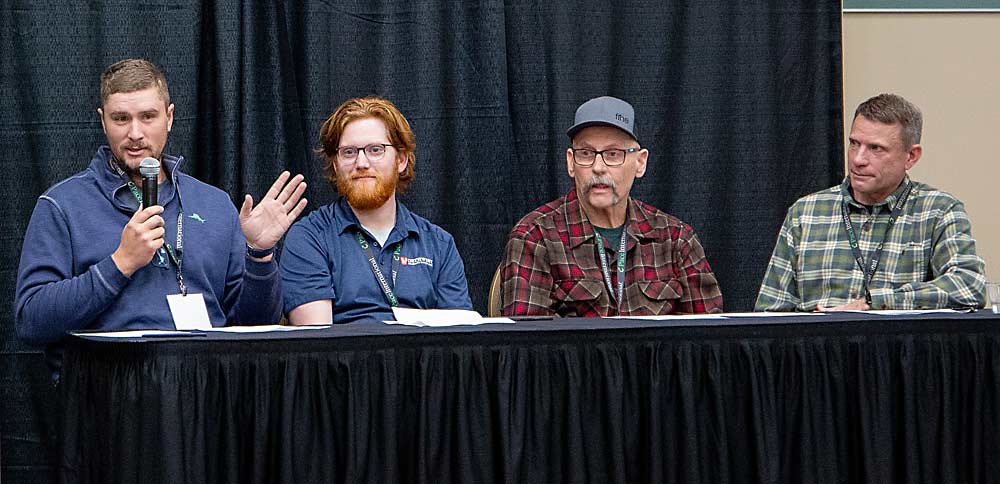
Use overhead washing, limit broad-spectrum sprays to pre-bloom, monitor for other pests and, above all, trust the process.
These were among the practical bits of advice shared by four pear growers during a panel discussion about a phenology-based integrated pest management (IPM) approach to psylla control in December at the Washington State Tree Fruit Association Annual Meeting.
The good news? IPM is working, according to Sam Parker, Chris Strohm, Mel Weythman and Keith Granger, Wenatchee-area pear growers and pest consultants who have changed practices in some orchards over the past two years.
The four men have, to varying degrees, implemented Washington State University’s new pear psylla degree-day model to time their applications most effectively. They’ve also begun using nonchemical tactics, such as early-season kaolin clay, to dissuade psylla from landing on pear trees, and overhead washing to rinse away the pest’s honeydew byproduct. It all adds up to an IPM program that could help the pear industry break the cycle of troubling pesticide resistance.
Tianna DuPont, Washington State University extension specialist, moderated the panel and advocated cautious optimism. She and her team have begun a scouting program to dial in thresholds of pests and predators to help growers decide when to spray (see “Evidence for inaction with psylla control”).
Meanwhile, 2023 was a low-pressure year for psylla anyway, so positive results deserve “a little bit of moderated enthusiasm,” she said.
The growers’ experiences shared a few common points.
Washing off honeydew, a sticky byproduct of psylla that damages fruit and frustrates pickers, was one of the hits, either by overhead systems or with a water-filled sprayer. In fact, Strohm, a crop advisor for Northwest Wholesale, recommended a washing system as one of the first steps for a grower considering IPM.
Broad-spectrum sprays still have their place, but use them pre-bloom to knock down overwintering adult populations, the growers said. After that, stick with selective sprays and washing to let predators do their jobs.
And trust those predators, or “beneficials” in IPM parlance. Most likely, the psylla population will spike midseason. It takes time, sometimes more than one season, for the good guys to set up shop.
“It can be a little bit scary,” said Parker in a follow-up conversation with Good Fruit Grower.
All four growers said they scout themselves as much as possible, but labor scarcity, overlapping insect generations and thick foliage late in the season make that difficult. The new psylla and predator scouting network support gave them more confidence.
Also, all four growers recommend vigilant trapping for other pests, such as codling moth, cutworm and boxelder bugs, while using new IPM strategies for psylla.
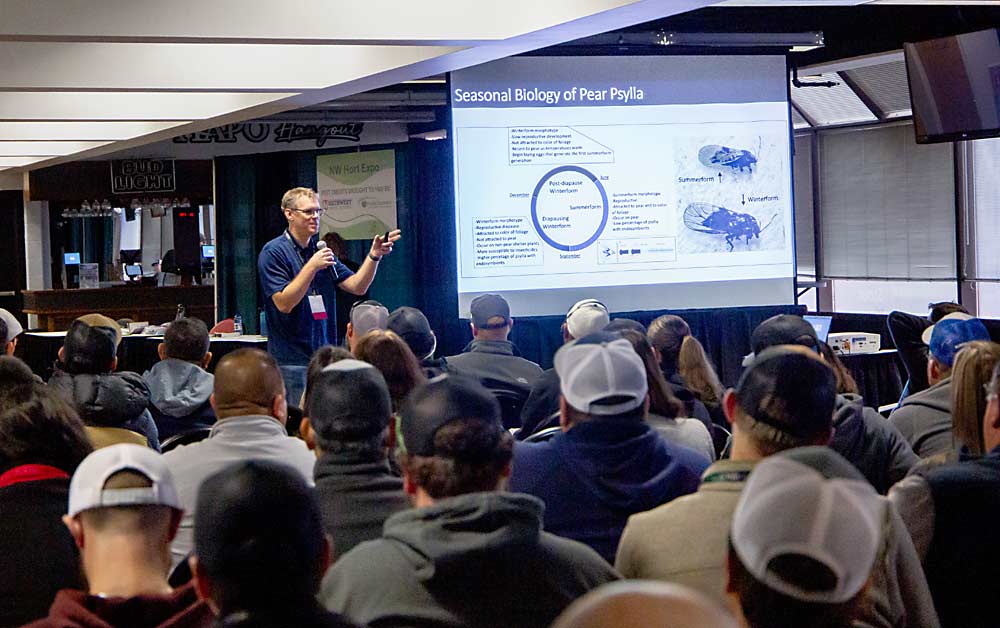
Further thoughts
Here are a few other experiences shared by the panel:
Weythman
Unlike his fellow panelists, Weythman went all in on IPM for his entire 50 acres in 2022.
“I guess I’m the oddball here because I put everything in the first year,” he said.
He starts the season by spraying kaolin clay, which makes the trees unattractive to psylla. He also uses oils and selective materials through July.After that, he relies on predator insects and overhead washing.
Parker
Parker’s family has a history of organic pear farming and started IPM in conventional blocks in 2022 to compare results.
His first trial was in a block that had been making good money. After some setbacks the first year, the block improved in 2023 with less late-season fruit damage than before the new program. In 2023, he expanded IPM to an adjacent conventional block that was not making any money. After only one year of integration, the block became clean and profitable again, he said.
He may expand his IPM blocks, based on communications with his neighbors who have expressed interest in doing the same.
One tip: For selective sprays, he mixes to a concentration of 100 gallons per acre, which is what most of his organic sprays call for, instead of diluting to 200 gallons.
Granger
Granger, a Wilbur-Ellis crop advisor, has turned to IPM as an alternative to organic farming but kept his recommendations similar to organic methods, just to keep management simple.
During 2022, a year with high psylla pressure, he switched 30 conventional acres to IPM and considered about half of that successful. Conditions improved in 2023.
Granger starts his season with three pre-bloom applications of Surround (kaolin clay). One of them includes an oil spray to knock down adult psylla, as well as control San Jose scale.
Strohm
Strohm spent four years working for DuPont as an entomology extension assistant for the pear IPM program. After starting at Northwest Wholesale, he implemented IPM on about 70 acres in 2022 and bumped that up to about 100 in 2023. His growers have been pleased and have asked him to help them expand.
For example, he and a grower started an IPM program in one orchard where conventional programs had a history of falling apart near harvest, due to psylla population booms and an overworked staff. In 2023, the grower harvested all of his fruit, including his latest pears, which typically suffered the most damage.
Anecdotally, he has noticed that larger areas of 20 acres or more have better success than small pockets of 4 or 5 acres.
—by Ross Courtney

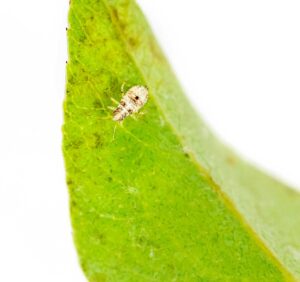
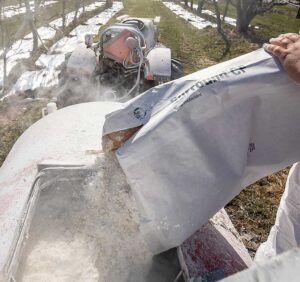
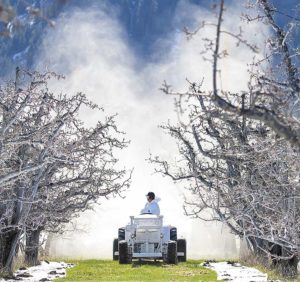





Leave A Comment